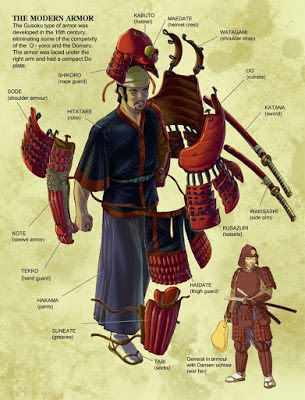Below is an excerpt of an article that appeared on the British Museum website about how they went about conserving a set of 17th century armor they had acquired. The full post, with many photographs, may be read here.
Using funds from the JTI Japanese Acquisition Fund, the Department of Asia has recently acquired a fine set of Japanese samurai armour and accessories dating from the 1700s. During the Edo period (1615–1868), Japan was largely at peace, so armour was more for ceremonial occasions than for battle. It was a beautifully decorative ensemble of finely crafted materials, including metal, lacquer, textile, leather and horn. Each of these presented different challenges for the team of conservators at the British Museum.
The samurai armour required extensive conservation and mounting before it could be put on display. This is because it had been privately owned with no known previous conservation records. After initial assessments it was clear that it was covered in dirt dust, had damage to the lacquer, degrading textiles, and needed structural support for mounting. During its 250+ hour treatment we learned a lot about the techniques used to create the armour, with some interesting surprises along the way!
When the object arrived at the Museum it was quarantined for several months to ensure that no pests or infestations were present. Usually objects will be frozen to kill any insects, but due to the amount of lacquer and metal (which can break when quickly expanding or contracting due to changes in temperature), quarantine was the best option. Many of the wood and horn pieces from the armour and its storage box showed signs of damage by pests. While wood damage can be seen as unsightly, interestingly some horn damage can be seen as a sign of affluence that the owner was able to afford real horn as opposed to a substitute.
One of the first things we did was clean the armour. There was a lot of dust in crevices that could scratch the surface when trying to spruce up the metal. We used a soft brush and a special Museum vacuum to carefully clean the dust off.
During a surface clean conservators can uncover partially obscured surfaces, helping us gain a better idea of the object's overall condition. For example, while cleaning the cuirass over 100 insect casings were found hidden beneath the silk cording.
The armour has several textile elements including the collar, shin guards, silk cords, tassels and sleeves – many of which had degraded over time and from light damage. Light damage fades dyes, and weakens the fibres causing them to split and disintegrate into fibre dust. The parts dyed a light orange/pink colour were especially damaged so our senior textile conservators set to work securing the loose fibres by using very fine silk thread and custom-dyed nylon netting where the armour needed additional support.
Our main concern was the lacquer covering nearly all of the armour. When lacquer is new it's glossy with a smooth, shiny surface that is resistant to most environmental conditions. But over time light can damage lacquer and create tiny microcracks in the surface, making the surface appear dull. The armour had many areas with cracks that needed treatment to protect the exposed areas and prevent any more damage.
Because the adhesive we use dries very slowly (it takes over five days), it is important that any area we are trying to stabilise has continuous pressure. For this, we use a modified Japanese method called shimbari – it utilises a wooden frame and flexible bamboo sticks that allow the conservator to apply even pressure across an entire surface, whether flat or curved, over a long period of time. Coupled with clamps, we were able to re-secure lacquer that no longer lay down flat.

No comments:
Post a Comment